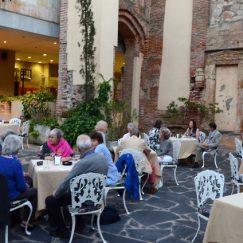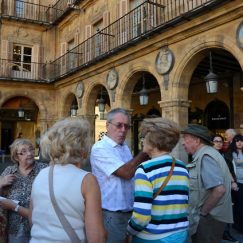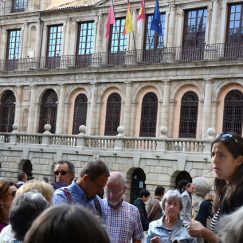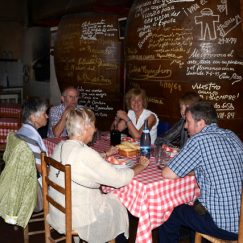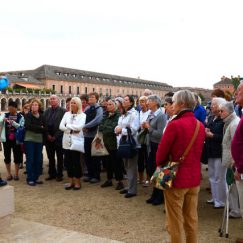
Spanish tour of Madrid, Salamanca and Toledo
Seven day tour of the ‘real Spain’
Tuesday 15 October – Monday 21 October 2013
Please see below for photos of this tour.
From the buzzing capital Madrid, to the medieval charm of Salamanca, Spain’s oldest university city, this is an escorted tour to the ‘real Spain’. Organised by Riviera Travel, the tour has been booked for October when it will still be warm but more comfortable than the mid-summer months. The capital Madrid is a great European city where you can visit the Prado museum, home to one of the world’s greatest art collections, including many works by the famous master, Goya; or see arguably Picasso’s best work, Guernica, in the Reina Sofia museum nearby. In Segovia, capital of the old kingdom of Castille, you have the most perfectly preserved Roman aqueduct in existence, some 2,000 years after it was first used. In Toledo, capital of Spain until the 16th century, you will find evidence of Christian, Jewish and Moorish civilisations. Salamanca, home to one of Europe’s oldest universities, boasts a wealth of lovely buildings and a highly ornate style of architecture known as Plateresque.
Itinerary
Day 1: You should arrive at the airport to take your flight to Madrid. On arrival a coach will take you to Salamanca, taking approximately two and a half hours, where we stay for the next two nights on a bed and breakfast basis. Your hotel is the excellent three-star superior San Polo located on the edge of the old town very near the cathedrals. The hotel is modern, charming and very unusual in that part of it is built on the site of an 11th century church, the remains of which have been incorporated into the design of the hotel and terrace. It has a good restaurant or you may choose to eat in one of Salamanca’s many and varied ones. Day 2: Salamanca, a UNESCO World Heritage site, is acknowledged by many Spaniards as one of the country’s most beautiful cities and when you see it, it really is difficult to disagree. Built virtually entirely of the local sandstone which gives it a gorgeous rose-coloured hue, it seems almost to glow, especially during the sunset. The beautiful setting, perched on a small hill on a bend in the serene river Tormes, is a picture of tranquillity despite the city’s violent heritage. Founded by the Romans, who built the 400 yard long bridge which is still in use, it was repeatedly fought over by Hannibal, the Moors and finally, the Duke of Wellington and Napoleon. Today, the city is dominated by its two cathedrals and university, the oldest in Spain founded in 1215 and for four centuries one of the most important seats of study in the civilised world. The records of the Spanish Inquisition are still kept here, it made major contributions to international law and, as early, as the sixteenth century boasted some twelve thousand students. You can see all the beautifully preserved lecture halls with vaulted ceilings and the library where you can imagine the moment Christopher Columbus came to address the most learned men of the day.
After breakfast, we have a guided tour of Salamanca during which you will see all this and more, with the remainder of the day free to explore as you wish. You must visit the two cathedrals – the more recent dates from the 16th century! Whilst the buildings themselves dominate the skyline, their internal decoration is just as breathtaking. Salamanca is a wonderful place to just wander: tiny streets, medieval squares, traditional shops, gardens, market places all add to its atmosphere. The main square, the Plaza Mayor, is widely acknowledged as the finest in the country and the hub of Salamantine life. With plenty of cafés and places to sit and watch the locals go by, it is the perfect venue to soak up the lovely atmosphere. For one of the most memorable views, simply cross the River and look back at the Roman bridge and the rose red city rising in the distance -perfection indeed!
Day 3: After breakfast we say goodbye to Salamanca, soon arriving in Segovia, capital of the old Kingdom of Castille and another lovely city. Dating back to Roman times, today it proudly boasts one of the most finely preserved Roman aqueducts in the world. Being over half a mile long and 100 feet high, this relic of the ancient world is all the more remarkable when you realise not a drop of mortar or cement has been used in its construction. It was also the home of Queen Isabella who commissioned Christopher Columbus to discover the New World. There are some superb Renaissance paintings in the cathedral but the fairy tale Alcazar, or castle, dominates the superb old city and should be visited if only for the fantastic panoramic views over the whole area. Segovia, though, like the other old cities of Spain, is untouched by the excesses of modern tourism and nothing could be better than watching the locals going about their everyday business, shopping in the market, exchanging a few words with friends in the street or enjoying that most traditional of pastimes, sampling a few tapas in a local bar. It is this blend of olde-worlde charm and modern-day reality which makes Segovia such a joy in which to pass a few hours.
We then continue our journey to Madrid and our hotel for the next four nights, the four-star Novotel, where we stay on a half-board basis. This hotel is well located in Madrid, being approximately three miles from Sol, the geographical centre of the city, set in its own gardens complete with swimming pool and terrace (open subject to weather conditions), and is fully air-conditioned. Some dates stay at the four-star Catalonia Gran Vía, on bed and breakfast basis with one evening meal included at a typical restaurant. Situated in the centre of Madrid on a thoroughfare showcasing early 20th century architecture and one of the city’s most important shopping areas, between Puerta del Sol and Plaza de Cibeles. Located in a charming building dating back to 1917, it offers a seasonal rooftop pool, a bar and restaurant. The rooms are decorated in neutral tones and are air-conditioned. Day 4: This morning after breakfast, we will have a sightseeing tour of Madrid, during which we will see some of the sights for which this capital city is most famous: the beautiful Plaza Mayor, the vast square in the heart of old Madrid; the Prado Museum with one of the world’s finest art collections, housing many great works by artists such as Goya and Dali; the Royal Palace, former official residence of the Royal Family; the Plaza De España home to a statue of the legendary Don Quixote; the Puerta del Sol, the point from which all distances in Spain are measured and marks the official centre of the country, plus much more. During the afternoon you are free to explore as you wish.
Day 5: Today we take the short drive out of Madrid to Aranjuez, home to the former summer palace and gardens of the Spanish Royal Family. Located at the confluence of two rivers, which makes the town admirably green, Aranjuez has a rather regal air, similar to Windsor, but it is the gardens for which it is most famous. A thick forest on the riverbanks has been creatively transformed into lovely gardens, where the air is heavy with the scent of magnolia and jacaranda. Successive monarchs have since modified the layout: the Hapsburgs ordered Flemish-style gardens with twisting lanes whereas the Bourbon dynasty built more in the ‘planned’, French style with hedges, lakes, extremely ornate fountains and fine sculpture. The Palace itself has been sympathetically restored and features beautifully displayed antiques, fabrics and exquisite furniture together with some outstanding works of art, glassware and porcelain. We visit the Palace after which you have free time to explore the gardens and town as you wish before returning to the hotel mid-afternoon. This evening we do not eat in the hotel but take the short drive to Chinchón, a beautiful, provincial village full of the atmosphere of rural Spain, famous for its pretty town square and locally produced aniseed liqueur. We arrive after siesta, when the town comes to life, and have a little time to wander and absorb its ambience before visiting a lovely restaurant, converted from a former olive mill, where you will be served specialities of the region.
Day 6: Just south of Madrid lies the beautiful city of Toledo, standing out against the often luminously blue Castilian sky; a golden biscuit coloured city rising from the plain and circled by a steep ravine filled by the turbulent waters of the river. It is as spectacularly rich in history, buildings and art as any city in the world can be and we spend most of the day here. Being at the crossroads of several cultures during its long and often violent past, it takes its influences from Jewish, Christian and Moorish civilisations. It was Philip II, builder of the Spanish Armada who moved the capital from Toledo to nearby Madrid, thus ensuring Toledo would survive in its totally unspoiled form. Nowadays it is most well known for its majestic Alcazar Palace perching on the top of the hill, its fantastic cathedral, richly adorned with treasures plundered from the New World, and its wealth of other buildings. Indeed El Greco lived here and you can visit his house where some of his paintings are displayed. The most lethal weapon of the 16th century world, the rapier, was invented here, and the city is still renowned today for its high quality metalwork. You are free to explore at your leisure and savour the serenity of this fascinating city. We leave Toledo late afternoon and return to our hotel. Today, at the appropriate time, the coach will take us to Madrid airport to take our return flight home.
